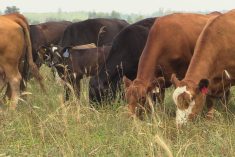Buyers kept a respectful distance from the market early in the week. Western Canadian feeder cattle markets were lackadaisical due to the bearish sentiment of the U.S. Department of Agriculture’s Cattle on Feed report. However, by Friday, all weight categories were trading steady with week-ago levels. Feedlot operators were bent upon ownership with an insatiable appetite for high quality yearlings. Alberta packers were buying fed cattle from $132 to $134. Feedlot shrugged off the weakness in the nearby fed cattle market because yearlings are fed cattle five months forward.
Read Also

U.S. grains: CBOT soybeans, corn, wheat fall in USDA data aftermath
Chicago grains took a dive on Friday, following a closely watched U.S. government crop report and the release of export data that could provide clues into Chinese buying.
In central Alberta, a smaller group of medium-frame, medium- to lower-flesh mixed steers weighing 900 lbs. rang the bell at $190 while heifers weighing 945 lbs. sold for $175. In southern Alberta, medium- to lower-flesh black steers averaging just under 950 lbs. sold for $194. In central Saskatchewan, steers around 850 lbs. were readily trading from $188 to $192 and mixed heifers averaging 825 lbs. were quoted at $170. Discounts were noted on fleshier cattle of $3 to as much as $7 in some cases.
Calves are starting to come onstream in larger volumes at this time of year. In Saskatchewan and Manitoba, 500- to 600-lb. steers were actually a slight premium to average values in Alberta. In central Alberta, black unweaned medium-frame steers averaging 520 lbs. sold for $223 while in central Saskatchewan, unweaned Charolais-Simmental steers averaging 515 lbs. reached up to $233. These calves were fair value compared to the yearlings; therefore, feedlots and backgrounders were active on these lower weight categories.
This past week, feeder prices divorced from the fed cattle market because lower beef production is expected in the first quarter of 2018. The feeder market has incorporated a risk premium due to the uncertainty in beef production during February and March. It’s hard to pencil some of these values, but the higher price structure has incentivized the cow-calf producer to sell cattle.
— Jerry Klassen manages the Canadian office of Swiss-based grain trader GAP SA Grains and Produits Ltd. and is president and founder of Resilient Capital, specializing in proprietary commodity futures trading and market analysis. Jerry consults with feedlots on risk management and writes a weekly cattle market commentary. He can be reached at 204-504-8339.















